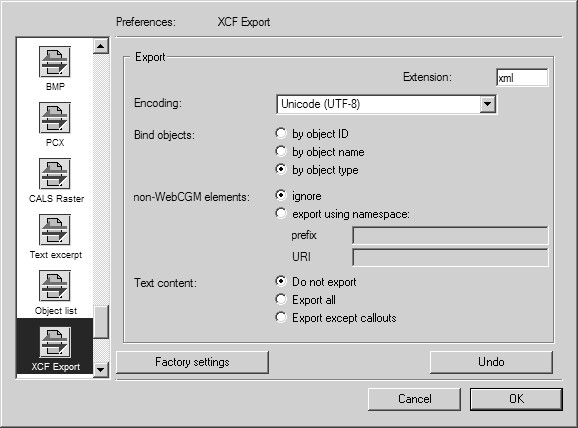XCF Export Settings
Choose > , then click the XCF Export symbol. The Preferences: XCF Export page appears:
Preferences: XCF Export page
You can change the XCF Export setting preferences described below on this page.
• Click OK to save your changes or Cancel to close the Preferences dialog box without saving.
• Click Undo to revert to your previous settings.
• Click Factory settings to reset all settings to their default values.
Encoding
Select the type of text encoding you want to use for the exported XCF. Typically, this is same text encoding your system uses. The text encoding does not affect the text content in the XCF; it only affects how your system displays it. The factory setting is Unicode (UTF-8).
Bind objects
by object ID
Creates bindByID XML elements in the XCF that are bound to ISO elements by the object ID value in the ISO file. The object ID value for an ISO element must be manually entered in the Object info dialog box or no bindByID XML element will be created for it in the XCF. (ISO elements with blank or automatically-generated ID values are ignored.)
The bindByID element’s apsid attribute matches the object ID value.
For example, the bindByID XML element for an ISO Line element with an object ID value of LINE_OBJECT-1 looks like this in the XCF:
<bindById apsid="LINE_OBJECT-1"/>
If you exported an ISO Text or Callout element with a manually-entered object ID, a bindByID XML element will be created in addition to the isodraw:textContent XML element. The bindByID XML element will be bound to that Text or Callout element in the ISO file by the object ID.
by object name
Creates bindByName XML elements in the XCF that are bound to ISO elements by the object Name value in the ISO file. The object Name value for an ISO element must be manually entered in the Object info dialog box or no bindByName XML element will be created for it in the XCF. (ISO elements with blank object Name values are ignored.)
The bindByName element’s apstargetname attribute matches the object Name value.
For example, the bindByName XML element for an ISO Polygon element with an object Name value of Polygon-3 looks like this in the XCF:
<bindByName apstargetname="Polygon-3"/>
If you exported an ISO Text or Callout element with a manually-entered object Name, a bindByName XML element will be created in the XCF in addition to an isodraw:textContent XML element. The bindByName XML element will be bound to that Text or Callout element in the ISO file by the object Name.
by object type
(Factory setting) Creates grobject XML elements in the XCF that are bound to ISO elements by the object ID value in the ISO file. The object ID value for an ISO element can be either manually entered or automatically generated in the Object info dialog box. (ISO elements with blank object ID values are ignored.)
The grobject element’s apsid attribute matches the object ID value.
For example, the grobject XML element for an ISO Rectangle element with an object ID value of AUTOID_1234 looks like this in the XCF:
<grobject apsid="AUTOID_1234"/>
If you exported an ISO Callout element, a grobject XML element will be created in the XCF in addition to an isodraw:textContent XML element. The grobject XML element will be bound to that Callout element in the ISO file by the object ID.
If you exported an ISO Text element with a manually-entered object ID, a grobject XML element will be created in the XCF in addition to an isodraw:textContent XML element. The grobject XML element will be bound to that Text element in the ISO file by the object ID. No grobject XML element will be created for the ISO Text element if the object ID value is blank or automatically-generated.
Non-WebCGM elements
ignore
(Factory setting) Uses the Arbortext IsoDraw-default namespace, http://www.ptc.com/isodraw/7.0/, and prefix, isodraw.
For example:
xmlns:isodraw="http://www.ptc.com/isodraw/7.0/"
Each exported non-WebCGM ISO element creates a grobject, bindbyName, or bindByID XML element in the XCF. The XML element name depends on the currently selected Bind objects option.
Each exported non-WebCGM Text or Callout ISO element creates an isodraw:textContent XML element in the XCF.
export using namespace
Uses the prefix and URI values entered for the namespace prefix and namespace.
Each exported non-WebCGM ISO element creates an XML element in the XCF. The name of the XML element depends on the object-info XML element definition(s) in URI, the user-defined namespace. The XML element name will reflect the currently selected Bind objects option if the user-defined namespace has different object-info XML element names for different bindings.
Each exported non-WebCGM Text or Callout ISO element creates an prefix:textContent XML element in the XCF, where prefix is the value of the user-defined namespace prefix.
| XML companion files are part of the WebCGM 2.0 Document Object Model (DOM). Arbortext IsoDraw files are WebCGM-compliant and can contain both WebCGM and non-WebCGM objects. Likewise, XML companion files exported from an ISO file can contain object info for both WebCGM and non-WebCGM objects. |
If you add non-WebCGM content to an XCF file, this content must use a separate namespace. The namespace distinguishes non-WebCGM text content added to the XCF file from WebCGM content in that XCF file.
Text content
Do not export
(Factory setting.) Creates no isodraw:textContent XML elements in the exported XCF
Export all
Creates an isodraw:textContent XML element in the exported XCF for every ISO Text and Callout element in the source ISO file.
Export except callouts
Creates an isodraw:textContent XML element in the exported XCF for every ISO Text element in the source ISO file, but none for ISO Callout elements.


